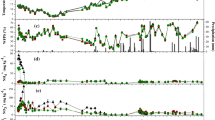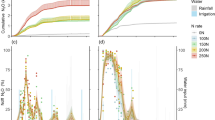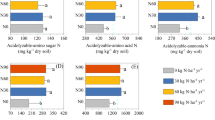Abstract
The application of inorganic nitrogen (N) fertilizers strongly influences the contribution of agriculture to the greenhouse effect, especially by potentially increasing emissions of nitrous oxide (N2O), carbon dioxide (CO2) and methane (CH4) from soils. The present microcosm-study investigates the effect of different forms of inorganic N fertilizers on greenhouse gas (GHG) emissions from two different agricultural soils. The relationship between greenhouse gas emissions and soil microbial communities, N transformation rates and plant (Hordeum vulgare L. cv. Morex) growth were investigated. Repeated N fertilization led to increased N2O emissions. In a parallel survey of functional microbial population dynamics we observed a stimulation of bacterial and archaeal ammonia oxidisers accompanied with these N2O emissions. The ratio of archaeal to bacterial ammonium monooxygenase subunit A (amoA) gene copies (data obtained from Inselsbacher et al., 2010) correlated positively with N2O fluxes, which suggests a direct or indirect involvement of archaea in N2O fluxes. Repeated N fertilization also stimulated methane oxidation, which may also be related to a stimulation of ammonia oxidizers. The fertilizer effects differed between soil types: In the more organic Niederschleinz soil N-turnover rates increased more strongly after fertilization, while in the sandy Purkersdorf soil plant growth and soil respiration were accelerated depending on fertilizer N type. Compared to addition of NH +4 and NO −3 , addition of NH4NO3 fertilizer resulted in the largest increase in global warming potential as a summary indicator of all GHG related effects. This effect resulted from the strongest increase of both N2O and CO2 emission while plant growth was not equally stimulated, compared to e.g. KNO3 fertilization. In order to decrease N losses from agricultural ecosystems and in order to minimize soil derived global warming potential, this study points to the need for interdisciplinary investigations of the highly complex interactions within plant-soil-microbe-atmosphere systems. By understanding the microbial processes underlying fertilizer effects on GHG emissions the N use efficiency of crops could be refined.



Similar content being viewed by others
References
Abdalla M, Jones M, Ambus P, Williams M (2009) Emissions of nitrous oxide from Irish arable soils: effects of tillage and reduced N input. Nutr Cycl Agroecosyst. doi:10.1007/s10705-009-9273-8
Ambus P (2005) Relationship between gross nitrogen cycling and nitrous oxide emission in grass-clover pasture. Nutr Cycl Agroecosyst 72:189–199
Ambus P, Zechmeister-Boltenstern S, Butterbach-Bahl K (2006) Sources of nitrous oxide emitted from European forest soils. Biogeosciences 3:135–145
Baggs EM, Blum H (2004) CH4 oxidation and emissions of CH4 and N2O from Lolium perenne swards under elevated atmospheric CO2. Soil Biol Biochem 36:713–723
Bedard C, Knowles R (1989) Physiology, biochemistry, and specific inhibitors of CH4, NH +4 , and CO oxidation by methanotrophs and nitrifiers. Microbiol Rev 53:68–84
Bodelier PLE, Roslev P, Hencke T, Frenzel P (2000) Stimulation by ammonium-based fertilizers of methane oxidation in soil around rice roots. Nature 403:421–424
Bouwman AF (1990) Exchange of greenhouse gases between terrestrial ecosystems and the atmosphere. In: Bouwman AF (ed) Soils and the greenhouse effect. Wiley, England, pp 61–127
Bouwman AF (1996) Direct emission of nitrous oxide from agricultural soils. Nutr Cycl Agroecosyst 45:53–70
Cardenas LM, Thorman R, Ashlee N, Butler M, Chadwick D, Chambers B, Cuttle S, Donovan N, Kingston H, Dhanoa MS, Scholefield D (2010) Quantifying annual N2O emission fluxes from grazed grassland under a range of inorganic fertiliser nitrogen inputs. Agr Ecosyst Environ 136:218–226
Cavagnaro TR, Jackson LE, Hristova K, Scow KW (2008) Short-term population dynamics of ammonia oxidizing bacteria in an agricultural soil. Appl Soil Ecol 40:13–18
Chu H, Hosen Y, Yagi K (2004) Nitrogen oxide emissions and soil microbial properties as affected by N-fertilizer management in a Japanese Andisol. Soil Sci Plant Nutr 50:287–292
Chu HY, Hosen Y, Yagi K (2007) NO, N2O, CH4 and fluxes in winter barley field of Japanese Andisol as affected by N fertilizer management. Soil Biol Biochem 39:330–339
Chu HY, Hosen Y, Yagi K, Okada K, Ito O (2005) Soil microbial biomass and activities in a Japanese Andisol as affected by controlled release and application depth of urea. Biol Fertil Soils 42:89–96
Davidson EA (1993) Soil water content and the ratio of nitrous oxide to nitric oxide emitted from soil. In: Oremland RS (ed) Biogeochemistry of global change. Radiatively active trace gases. Chapman & Hall, New York, pp 369–384
De Visscher A, Van Cleemput O (2003) Induction of enhanced CH4 oxidation in soils: NH +4 inhibition patterns. Soil Biol Biochem 35:907–913
Di HJ, Cameron KC, Shen JP, Winefield CS, O’Callaghan M, Bowatte S, He JZ (2009) Nitrification driven by bacteria and not archaea in nitrogen-rich grassland soils. Nat Geosci 2:621–624
Dobbie KE, Smith KA (2001) The effects of temperature, water-filled pore space and land use on N2O emissions from an imperfectly drained gleysol. Eur J Soil Sci 52:667–673
Dobbie KE, Smith KA (2003) Nitrous oxide emission factors for agricultural soil in Great Britain: the impact of soil water-filled pore space and other controlling variables. Glob Change Biol 9:204–218
Duxbury JM, Harper LA, Mosier AR (1993) Contribution of agroecosystems to global climate change. In: Harper LA, Mosier AR, Duxbury JM, Rolston DE (eds) Agricultural ecosystem effects on trace gases and global climate change. ASA Special Publication No. 55. American Society of Agronomy, Madison, pp 1–18
Enwall K, Nyberg K, Bertilsson S, Cederlund H, Stenström J, Hallin S (2007) Long-term impact of fertilization on activity and composition of bacterial communities and metabolic guilds in agricultural soil. Soil Biol Biochem 39:106–115
Flessa H, Ruser R, Dörsch P, Kamp T, Jimenez MA, Munch JC, Beese F (2002) Integrated evaluation of greenhouse gas emissions (CO2, CH4, N2O) from two farming systems in southern Germany. Agr Ecosyst Environ 91:175–189
Francis CA, Beman JM, Kuypers MMM (2007) New processes and players in the nitrogen cycle: the microbial ecology of anaerobic and archaeal ammonia oxidation. ISME J 1:19–27
Garrido D, Henault C, Gaillard H, Perez S, Germon JC (2002) N2O and NO emissions by agricultural soils with low hydraulic potentials. Soil Biol Biochem 34:559–575
Gavrichkova O, Kuzyakov Y (2008) Ammonium versus nitrate nutrition of Zea mays and Lupinus albus: effect on root-derived CO2 efflux. Soil Biol Biochem 40:2835–2842
Glaser K, Hackl E, Inselsbacher E, Strauss J, Wanek W, Zechmeister-Boltenstern S, Sessitsch A (2010) Dynamics of ammonia oxidizing communities in barley planted bulk soil and rhizosphere following nitrate and ammonium fertilizer amendment. FEMS Microbiol Ecol. doi:10.1111/j.1574-6941.2010.00970.x
Granli T, Bockman OC (1994) Nitrous oxide from agriculture. Norw J Agr Sci 12(Suppl):1–128
Hall SJ, Matson PA (1999) Nitrogen oxide emissions after nitrogen additions in tropical forests. Nature 400:152–155
Hayatsu M, Tago K, Saito M (2008) Various players in the nitrogen cycle: diversity and functions of the microorganisms involved in nitrification and denitrification. Soil Sci Plant Nutr 54:33–45
Hilger HA, Barlaz MA, Wollum AG (2000) Landfill methane oxidation response to vegetation, fertilization, and liming. J Environ Qual 29:324–334
Hu R, Hatano R, Kusa K, Sawamoto T (2002) Effect of nitrogen fertilization on methane flux in a structured clay soil cultivated with onion in central Hokkaido, Japan. Soil Sci Plant Nutr 48:797–804
Hutchinson GL, Davidson EA (1993) Processes for production and consumption of gaseous nitrogen oxides in soil. In: Harper LA, Mosier AR, Duxbury JM, Rolston DE (eds) Agricultural ecosystem effects on trace gases and global climate change. ASA Special Publication No. 55. American Society of Agronomy, Madison, pp 79–94
Hütsch BW (1998) Tillage and land use effects on methane oxidation rates and their vertical profiles in soil. Biol Fertil Soils 27:284–292
Hütsch BW (2001) Methane oxidation in non-flooded soils as affected by crop production—invited paper. Eur J Agron 14:237–260
Inselsbacher E, Hinko-Najera Umana N, Stange FC, Gorfer M, Schüller E, Ripka K, Zechmeister-Boltenstern S, Hood-Novotny R, Strauss J, Wanek W (2010) Short-term competition between crop plants and soil microbes for inorganic N fertilizer. Soil Biol Biochem 42:360–372
Inselsbacher E, Ripka K, Klaubauf S, Fedosoyenko D, Hackl E, Gorfer M, Hood-Novotny R, Von Wiren N, Sessitsch A, Zechmeister-Boltenstern S, Wanek W, Strauss J (2009) A cost-effective high-throughput microcosm system for studying nitrogen dynamics at the plant-microbe-soil interface. Plant Soil 317:293–307
IPCC (1997) In: Watson RT, Zinyowera MC, Moss RH (eds) Special report on regional impacts of climate change: an assessment of vulnerability. A special report of IPCC working group II. Cambridge University Press, UK
IPCC (2001) Climate change 2001, The scientific basis—contribution of working group I to the third assessment report of IPCC. Cambridge University Press, Cambridge
IPCC (2007) Climate change 2007: Synthesis report. Contribution of working groups I, II and III to the fourth assessment report of the intergovernmental panel on climate change [Core Writing Team, Pachauri RK, Reisinger A (eds.)]. IPCC, Geneva
Isermann K (1994) Agriculture’s share in the emission of trace gases affecting the climate and some cause-oriented proposals for sufficiently reducing this share. Environ Pollut 83:95–111
Jackson J, Choudrie S, Thistlethwaite G, Passant N, Murrells T, Watterson J, Mobbs D, Cardenas L, Thomson A, Leech A (2009) UK greenhouse gas inventory, 1990 to 2007 annual report for submission under the framework Convention on Climate Change, AEA Technology, p.71
Jia Z, Conrad R (2009) Bacteria rather than archaea dominate microbial ammonia oxidation in an agricultural soil. Environ Microbiol 11:1658–1671
Jones SK, Rees RM, Skiba UM, Ball BC (2007) Influence of organic and mineral N fertiliser on N2O fluxes from a temperate grassland. Agr Ecosyst Environ 121:74–83
Kammann C, Hepp S, Lenhart K, Müller C (2009) Stimulation of methane consumption by endogenous CH4 production in aerobic grassland soil. Soil Biol Biochem 41:622–629
Kandeler E, Gerber H (1988) Short-term assay of soil urease activity using colorimetric determination of ammonium. Biol Fertil Soils 6:68–72
Kightley D, Nedwell DB, Cooper M (1995) Capacity for methane oxidation in landfill cover soils measured in laboratory-scale soil microcosms. Appl Environ Microbiol 61:592–601
Kilian S, Werner D (1996) Enhanced denitrification in plots of N2-fixing faba beans compared to plots of a non-fixing legume and non-legumes. Biol Fertil Soils 21:77–83
Kitzler B, Zechmeister-Boltenstern S, Holtermann C, Skiba U, Butterbach-Bahl K (2006) Nitrogen oxides emission from two beech forests subjected to different nitrogen loads. Biogeosciences 3:293–310
Klemedtsson L, Svensson BH, Rosswall T (1987) Dinitrogen and nitrous oxide produced by denitrification and nitrification in soil with and without barley plants. Plant Soil 99:303–310
Leininger S, Urich T, Schloter M, Schwark L, Qi J, Nicol GW, Prosser JI, Schuster SC, Schleper C (2006) Archaea predominate among ammonia-oxidizing prokaryotes in soils. Nature 442:806–809
Lou J, De Klein CAM, Ledgard SF, Saggar S (2010) Estimation of nitrous oxide emission from ecosystems and its mitigation technologies. Agr Ecosyst Environ 136:282–291
Madsen EL (2005) Identifying microorganisms responsible for ecologically significant biogeochemical processes. Nat Rev Microbiol 3:439–446
Martens-Habbena W, Berube PM, Urakawa H, DeLaTorre JR, Stahl DA (2009) Ammonia oxidation kinetics determine niche separation of nitrifying Archaea and Bacteria. Nature 461:976–979
Matson PA, Naylor R, Ortiz-Monasterio I (1998) Integration of environmental, agronomic, and economic aspects of fertilizer management. Science 280:112–115
Mosier AR (1994) Nitrous oxide emissions from agricultural soils. Fertil Res 37:191–200
Mosier AR (1998) Soil processes and global change. Biol Fertil Soils 27:221–229
Mosier AR, Guenzi WD, Schweiger EE (1986) Soil losses of dinitrogen and nitrous oxide from irrigated crops in northeastern Colorado. Soil Sci Soc Am J 50:344–348
Mosier AR, Schimel D, Valentine D, Bronson K, Parton W (1991) Methane and nitrous oxide flux in native, fertilized and cultivated grasslands. Nature 350:330–332
Myrold DD, Tiedje JM (1985a) Diffusional constraints on denitrification in soil. Soil Sci Soc Am J 49:651–657
Myrold DD, Tiedje JM (1985b) Establishment of denitrification potential in soils: effects of carbon, nitrate and moisture. Soil Biol Biochem 17:819–822
Offre P, Prosser JI, Nicol GW (2009) Growth of ammonia-oxidizing archaea in soil microcosms is inhibited by acetylene. FEMS Microbiol Ecol 70:99–108
Philippot L, Hallin S, Börjesson G, Baggs EM (2008) Biochemical cycling in the rhizosphere having an impact on global change. Plant Soil 321:61–81
Pörtl K, Zechmeister-Boltenstern S, Wanek W, Ambus P, Berger TW (2007) Natural 15 N abundance of soil N pools and N2O reflect the nitrogen dynamics of forest soils. Plant Soil 295:79–94
Raich JW, Tufekcioglu A (2000) Vegetation and soil respiration: correlations and controls. Biogeochemistry 48:71–90
Reay DS, Nedwell DB (2004) Methane oxidation in temperate soils: effects of inorganic N. Soil Biol Biochem 36:2059–2065
Regina K, Pihlatie M, Esala M, Alakukku L (2007) Methane fluxes on boreal arable soils. Agric Ecosyst Environ 119:346–352
Scheer C, Wassmann R, Butterbach-Bahl K, Lamers JPA, Martius C (2009) The relationship between N2O, NO and N2 fluxes from fertilized and irrigated dryland soils of the Aral Sea Basin, Uzbekistan. Plant Soil 314:273–282
Sitaula BK, Hansen S, Sitaula JIB, Bakken LR (2000) Methane oxidation potentials and fluxes in agricultural soil: effects of fertilisation and soil compaction. Biogeochemistry 48:323–339
Smith C, Dobbie KE, Ball BC, Bakken LR, Sitaula BK, Hansen S, Brumme R, Borken W, Christensen S, Prieme A, Fowler D, Macdonald AJ, Skiba U, Klemedtsson L, Kasimir-Klemedtsson A, Degorska A, Orlanski P (2000) Oxidation of atmospheric methane in northern European soils, comparison with other ecosystems, and uncertainties in the global terrestrial sink. Glob Change Biol 6:791–803
Soussana JF, Allard V, Pilegaard K, Ambus P, Amman C, Campbell C, Ceschia E, Clifton-Brown J, Czobel S, Domingues R, Flechard C, Fuhrer J, Hensen A, Horvath L, Jones M, Kasper G, Martin C, Nagy Z, Neftel A, Raschi A, Baronti S, Rees RM, Skiba U, Stefani P, Manca G, Sutton M, Tuba Z, Valentini R (2007) Full accounting of the greenhouse gas (CO2, N2O, CH4) budget of nine European grassland sites. Agric Ecosyst Environ 121:121–134
Spott O, Russow RWB, Apelt B, Stange F (2006) A N-15-aided artificial atmosphere gas flow technique for online determination of soil N2 release using the zeolite Köstrolith SX6. Rapid Commun Mass Spectrom 20:3267–3274
Steudler PA, Bowden RB, Melillo JM, Aber JD (1989) Influence of nitrogen fertilization on methane uptake in temperate forest soils. Nature 341:314–315
Szukics U, Hackl E, Zechmeister-Boltenstern S, Sessitsch A (2009) Contrasting response of two forest soils to nitrogen input: rapidly altered NO and N2O emissions and nirK abundance. Biol Fertil Soils 45:855–863
Treseder KK (2008) Nitrogen additions and microbial biomass: a meta-analysis of ecosystem studies. Ecol Lett 11:1111–1120
Verma A, Tyagi L, Yadav S, Singh SN (2006) Temporal changes in N2O efflux from cropped and fallow agricultural fields. Agric Ecosyst Environ 116:209–215
von Fischer JC, Hedin LO (2007) Controls on soil methane fluxes: Tests of biophysical mechanisms using stable isotope tracers. Global Biogeochem Cy 2:GB2007
Wang Z, Ineson P (2003) Methane oxidation in a temperate coniferous forest soil: effects of inorganic N. Soil Biol Biochem 35:427–433
Yavitt JB, Downey DM, Lang GE, Sextone AJ (1990) Methane consumption in two temperate forest soils. Biogeochemistry 9:39–52
Acknowledgements
This work was supported by Project Nitrogenome (Enhancing nitrogen use efficiency by opening up the microbial black-box) LS-05-36 granted by the Vienna Science and Technology Fund WWTF. It was also partly funded by the European Commission through the NitroEurope Integrated Project 017841.
Author information
Authors and Affiliations
Corresponding author
Additional information
Responsible Editor: Per Ambus.
Rights and permissions
About this article
Cite this article
Inselsbacher, E., Wanek, W., Ripka, K. et al. Greenhouse gas fluxes respond to different N fertilizer types due to altered plant-soil-microbe interactions. Plant Soil 343, 17–35 (2011). https://doi.org/10.1007/s11104-010-0597-6
Received:
Accepted:
Published:
Issue Date:
DOI: https://doi.org/10.1007/s11104-010-0597-6




